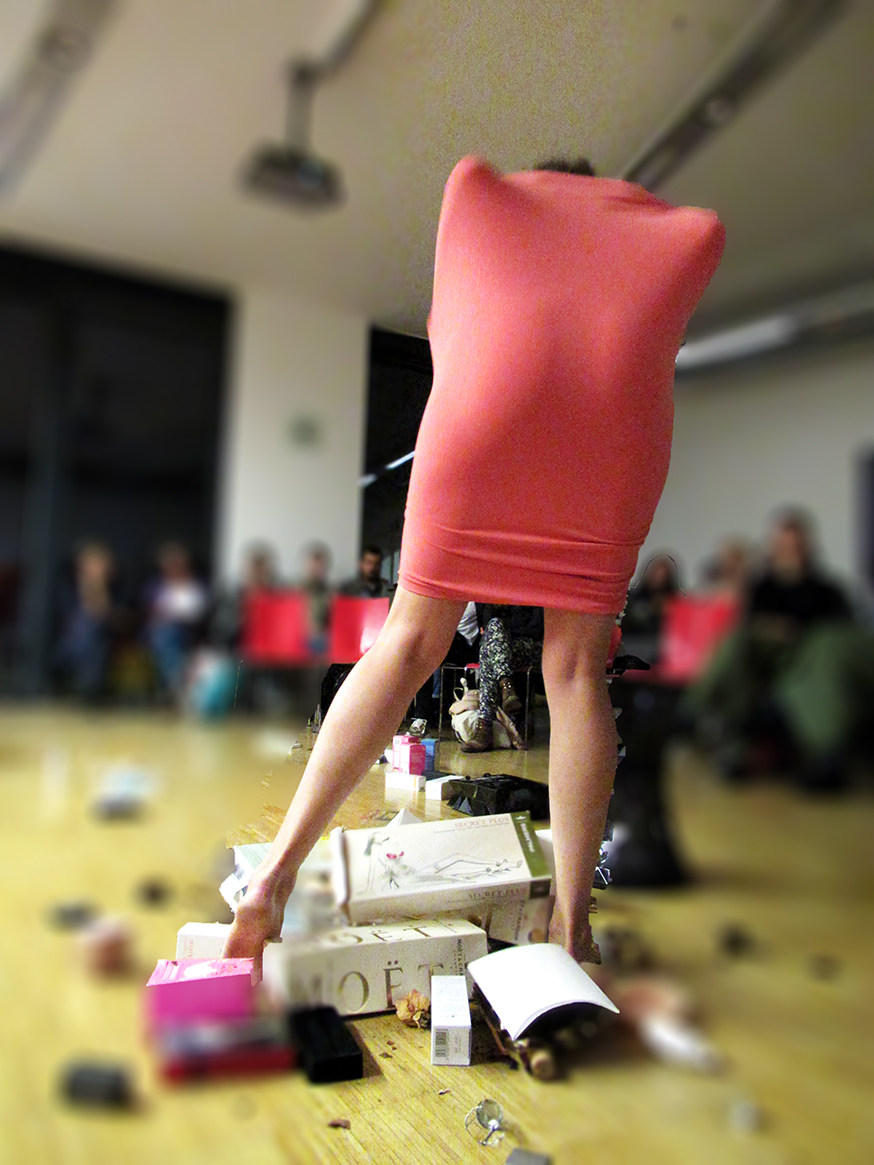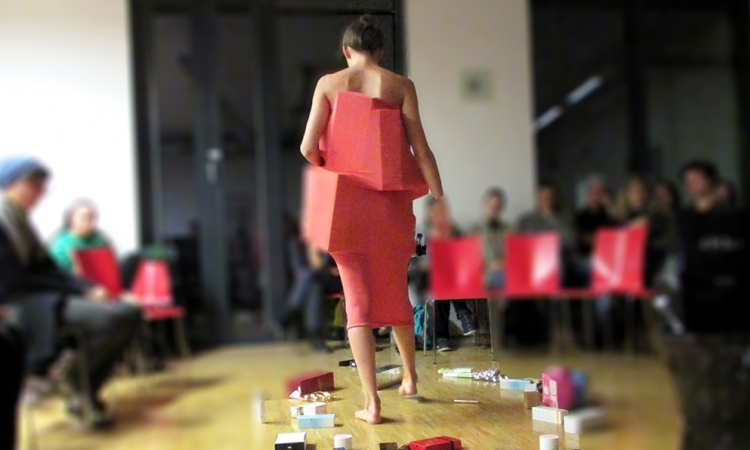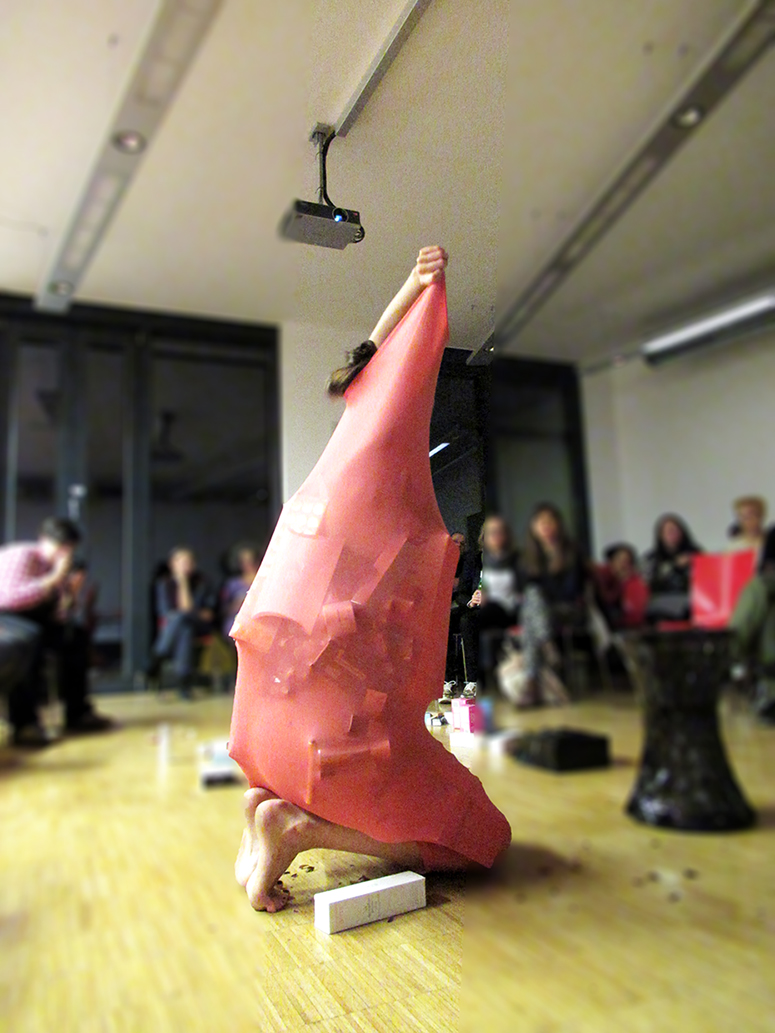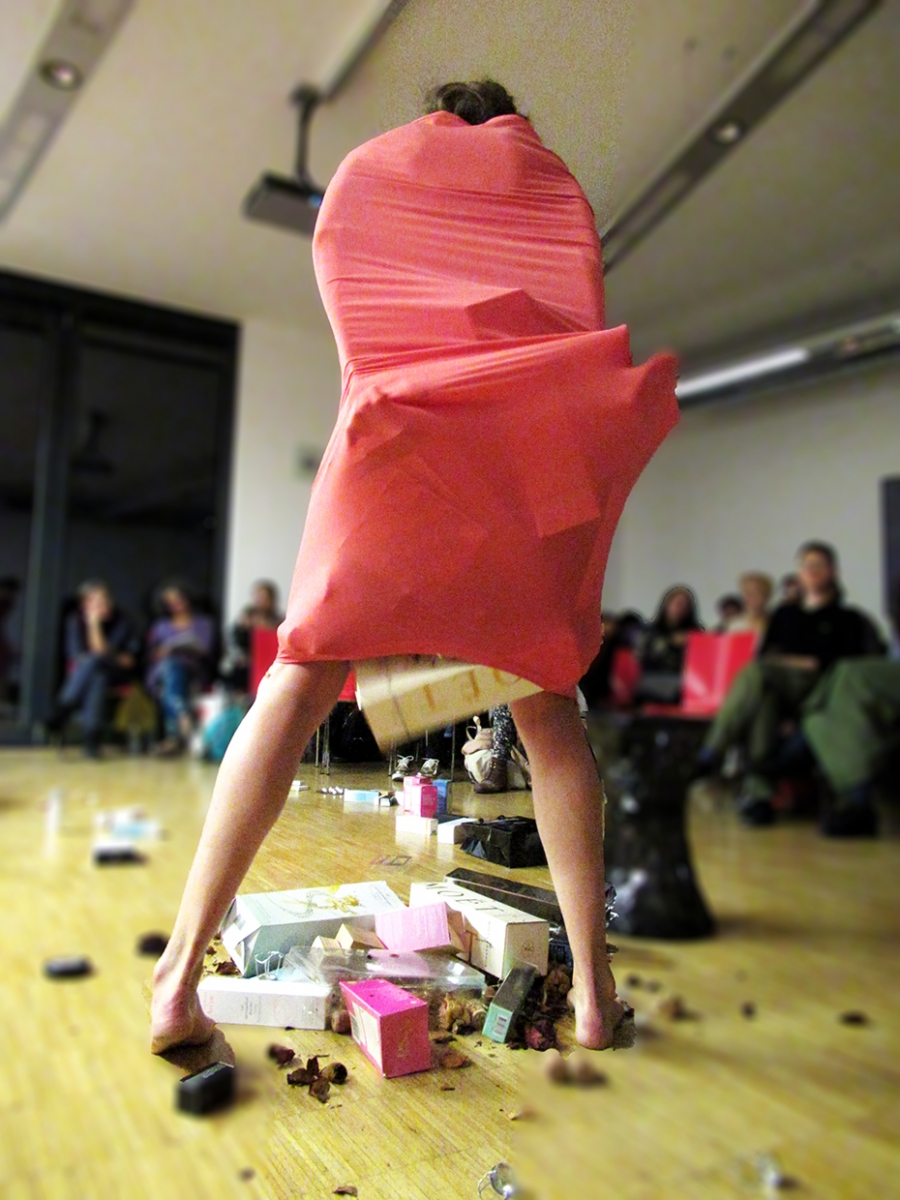Otilia’s Enigma, Notes on the Performance
positionality. followed by the ghost of beauty
Let’s take a day of the week. Any day. It could have been yesterday. Walking into a supermarket to buy food ahead of a long day of work, living as a migrating artist from Romania in Vienna. He, my co-national migrant asking for money in front of the supermarket, calls me while passing by “frumoaso” (“beautiful” – Romanian language) “hast du ein bisschen Kleingeld?” (“do you have some spare money?” – German language). While I pass by, not interacting, I hear his verdict: “cea mai frumoasa nu e” (Romanian language, “she is not the most beautiful”). I know this kind of sanctions. I have been shamed all my life on the streets in Romania that I do not possess beauty. I have been dissected, my body parts have been chopped off: “why did God made such a good body[1] and put such an ugly face on top of it?” they would say. It took and still takes a lot of strength to defend my space and my body, and claim the space of difference as beauty, or the space of beauty as difference. But I cannot say I do not shiver when I pass by a group of adolescent loud men even today.
However, I cannot but wonder what kind of space is being condensed, as the violence of misogynist normative language hits the body on a terrain where that exact type of beauty and femininity one is accused to be lacking, are being accused from another perspective as obsolete, as tussi (German pejorative word for bimbo: all dressed up and made up girl, who lacks intelligence). In other words: when I am hearing Romanian language words addressed to me in Vienna from a man who doesn’t know I speak the language (so one could claim he is speaking to himself) am I in Vienna (a certain West)? Or do I get teleported back (a certain East)? I think the space condensed in this kind of interaction entails both, and even more, points to their interconnectivity (on the muddy terrain of beauty). Do his words get more power over me because I can hear them so clearly from the other non-maternal languages people speak around me in front of the supermarket? Within this babel-tower, do we actually get along? Do his words have another meaning in this space, where actually he is choosing to speak with himself? Is it my choice to hear him? Am I hearing him? Or is it the normative culture roaring around, decompressing through his mouth, using his body. Do I confront him, or do I solidarize, seeing him as victim of patriarchy and oppression? Of course, all these different variations in reading reflect my positionality, and I do not want to demonize other migrant experiences, which do not contain the privilege of being able to do intellectual work. I imagined the performance at the intersection of two western discourses: on the one hand a maybe obsolete view held by ‘older’ western feminisms, saying that you cannot be a feminist and feminine at the same time; and the particular kind of femininity being sold to the space I come from as an embodiment of the west on the other hand. Eastern European women function in the latter discourse as an enabler of a western lifestyle, that is based on and at the same time reaffirms an idealized, fantasy image of the feminine and of the West.
In the process of thinking the performance, I also tried to frame the eastern mystique by thinking of the idea of the monster as proto-cyborg, as proposed by Theodora Eliza Văcărescu. If Mary Shelly’s Monster is understood a genderless being, much like the cyborg (Văcărescu 2004, 150), and the creation of Western culture itself (Văcărescu 2004,148), than the whole fabrication of a heterosexual partner for ‘him’ (Văcărescu 2004, 149-150), which would be the easternexacerbation of what Preciado calls the “semitechnical codes of white heterosexual femininity belonging to the postwar pharmacopornographic political ecology: [such as] (…) knowing how to give a good blow job (…) taking care of your hair, fashion, (…) the beauty imperative, (…) the manicure, (…) letting yourself be fucked in the ass when it’s necessary, (…) the smile, (…) being a kept woman” (Preciado 2013, 120–121), would not satisfy the desires of the monster anyway, because the monster eludes exactly this gender difference (Văcărescu, 2004,150). She also writes that there is no coincidence that “both, Shelley’s monster and Haraway’s cyborg are women’s creations” (Vacarescu 2004, 147), so therefore I say that there is no coincidence that the monster created by the consumer feminism invasion of the east is not.
I subscribe to Preciado’s analysis that “normative white heterosexuality will soon be one body aesthetic among many others, a retro reproductive style that various future generations will be able to denigrate or exalt, a low – tech reproduction machine possibly exportable to other parts of the world (…), but completely out of date and decadent in Western democratic post-Judeo-Christian societies” (Preciado 2013, 126). From this perspective, I choose to see critically policing one’s femininity, especially if it’s a different kind of femininity the one criticizing does not subscribe to. I believe a hegemonic structure is present whenever this kind of policing occurs. That’s why I am due to see critically my intervention as well and my positionality towards the Romanian space, since I have now become an artist and thinker trained in the West. Therefore, I would claim that femininity needs to be reframed and not restrained. Since it is obvious that it is informed by global capitalism, consumerism and what Preciado calls the pharmacopornographic regime, it is impossible to reframe femininity as a personal choice, while at the same time it is wrong to police its bearers for exactly the same reasons.


getting the memo: beauty means work
The ghost of beauty as a connection to the West has been haunting the proximate eastern territoriality for a long time. The biopolitical regimes have disciplined bodies: from the eugenic influenced interwar period, where “women were not to be counted as autonomous individuals but rather as dependents, since their eugenic role would be limited to human reproduction rather than economic production” (Bucur 2002, 98), to the biopolitical footprint of communist regime. According to theorist Petruța Teampău, communist discourse reframed feminine beauty as a “cluster of qualities” and “no longer a quality in itself” (Teampău 2011, 215), as well as reinforcing femininity and beauty as social responsibilities: “a women was beautiful only if she acted according to communist ethics” (Teampău 2011, 215).
If in the 1940s, Romanian women’s magazines, the visual representation of woman had a short lived period where it relied on the image of Hollywood stars (before changing direction towards soviet influences): a standardized beauty, youth and glamour, the post-communist regime of 1989’ saw a return of this “Western female body” image (Mîndruţ2006, 22). Even more, as the author writes, “after communism, freedom was experienced on the site of the body (…), a new body” (Mîndruţ 2006, 13). The methodological renewal (everything new) after communism, had as a consequence the fact that my generation (the children born shortly before or after 1989) were in a way left without a past, since the past was constantly being denied. ‘Communism never happened’ (2006) art piece by the Romanian artists Ciprian Muresan speak to me exactly about this. The process of recuperating memory becomes very important and is definitely one that our generation will have to continue. The neo-capitalist regime was quick to occupy these apparently empty spaces. The market, newly inaugurated and instantly celebrated, was “flooded with no longer censored images of the body: sexy, fit, naked bodies, i.e., Western bodies” (Mîndruţ 2006, 13). “In postsocialist Romania, the body – the female one per excellentiam – became a powerful signifying tool, marking the break with the communist past and the onset of a new age. The body was not only the locus of enjoying the fresh sense of freedom, but also the symbol of a new, better life, and the marker of the individual’s commitment to such a life. The image of the “Western” female body (sexy, tanned, and slim) became, for both Romanian men and women, the epitome of Western culture and of a desirable lifestyle” (Mîndruţ 2006, 22). If I may quote the title of an article by Holly Porteous: “From Barbie to the oligarch’s wife: reading fantasy femininity and globalization in post-Soviet Russian women’s magazines” (Porteous 2017), I would claim that this was a powerful narrative about achievement and women, and was mainly used to sell the products and affinities (personal development classes, sports, etc.) to eager future ‘princesses’ on the eastern post-communist terrain. While I am aware I could have been inclined to pick up this message because I was so clearly excluded from this kind of rewards, it is also obvious that it is exactly the customer they address, since the Barbie prototypes ought to be always in the process of improvement, while “imagined to be potentially ‘flawless’” (Steyerl 2012, 163).
Sian Stephenson even uses the term ‘fantasy feminism’ to argue for the way westernized editions of woman’s magazine entered the Russian market after the fall of communism and were used instrumentally to enable and sustain consumerism, by promoting a feminism that created “a creature that existed outside the constraints of reality”(Stephenson 2007, 615).
in the land of the beautiful
It is from this soil that human Barbie could emerge (Bianca Draguseanu in Romania and Valeria Lukyanova in Ukraine are the examples I can think of right now). I cannot but think of the essay by Hito Steyerl “The Spam of the Earth: Withdrawal from Representation” published in the “Wretched of the Screen”, where she actually claims that image spam could be seen as a way of people withdrawing from representation altogether. “Rather than a document of domination, image spam is the people’s monument of resistance to being represented like this. They are leaving the given frame of representation” (Steyerl 2012, 169). She then adds “the image-spam people are double agents. They inhabit both the realms of over- and invisibility. This may be the reason why they are continuously smiling but not saying anything” (Steyerl 2012, 173). Can we thus read the human Barbie bodies as denying norms while at the same time over-exaggerating them? Remember, we are on the terrain of artistic investigations, and I am trying to find alternative readings.
To go back to the post-communist Romanian terrain, we will of course encounter the actual reading of Bianca’s success story. Lucky Studio (http://luckystudio.ro/), an award winning video chat studio from the city of Iasi, run exclusively by women is offering an extraordinary bonus for a three year contract, namely silicone implants. The logo of the site says “esti libera sa faci bani” (“you are free to make money”). This is not the communist call for women’s emancipation in the work sphere (which failed anyway according to feminist thinker Mihaela Miroiu), nor the call for sexual liberation of women from the traditionalist orthodox Romanian society, but a capitalist call, equating emancipation this time with money. Just to be clear, it is not the sex work per se that I am criticizing here, but the framing through the somehow surreal TV reportages, surreal if we think of their actual patriarchal, traditionalist and orthodoxly charged viewers. In them[2] the accent is posed on the goods and lifestyle made available by earning a high income, which is at the same time dependent on how good one is. This good is never extended on. The sexuality of the working bodies is actually not present. It is at most equated with a camera shot of a cleavage with augmented breasts. Sexuality remains denied, as it is dangerous. Women’s sexuality is cut away in the presentation video made for the general public, the sexuality mentionedis that of the paying customer. There is no doubt that the women’s sexuality is present, it is just cut out of the narrative, because bringing it in would mean challenging orthodox society in a way that it consciously avoids. The reportages also feature testimonials from workers on how easy it is to conceal the job one is doing and the message is that this should be encouraged. Pharmacopornocapitalism flourishes in the most orthodox societies. The emancipatory tone of these videos does not come from a liberated understanding of femininity – what Preciado calls potentia gaudendi: “femininity, far from being nature, is the quality of the Orgasmic Force when it can be converted into merchandise, into an object of exchange, into work” (Preciado 2013, 46-47), but from a capitalist understanding of freedom, freedom to buy: femininity bought through breast implants, which is then bought by the paying (western) customer, whose money is then used as argument for (and not against). Of course, with this example I am oversimplifying, and I have not elaborated in the text about the social exclusion of these body discourses. Otilia’s enigma was trying to get into the body of (following is the closing section of my text; my initial notes before the piece was even performed): The ‘real women’, the good girls of the east. Projections of patriarchal concepts of femininity. Acting. Sexual role codes. Silicone and white teeth. Silicone implants as bonus for a 3-year contract. Call today. Sure you would like to look good. Economic development dependent on you. Grooming industry. Pharmacy. Air traffic. The restaurant bills. Telecommunication and don’t forget to vote for the ‘traditional family’. The country thanks you for your service.
Black sea, big cities, programming industry, international hotel chains, massage parlors, clubs and Instagram. TV assistants. Prices go high…Class dynamic, escaping material and social conditions, projections of social phantasies and of course the success stories. Bianca. An east side [street] story. You sure enjoy living the American dream. 24/7. Exclusions included.
The parmacopornographic era on the ‘cosmopolitan’ Romanian terrain where neoliberal policies are being ‘deflowered’ as we speak. Scripting national narratives. Insisting on heteronormativity. Assignment of roles. Politics and pimp politicians.


Acknowledgements:
I thank Viktoria Pötzl for documenting my performance, Dani Baumgartner from Frauensolidarität Wien for all the support and to all the participants of the conference for allowing me to be part of the conversation.
Bucur, Maria. 2002. “The biopolitical state.” Eugenics and Modernization in Interwar Romania, 78–121. University of Pittsburgh Press.
Mîndruţ, Petruţa. 2006. “Aerobic and Self-Asserting Discourses: Mapping the Gendered Body in Post-socialist Romania.” The Anthropology of East Europe Review, 24 (2): 13–24 .
Miroiu, Mihalea. 2004. Drumul către autonomie: Teorii politice feministe. Iaşi: Polirom.
Porteous, Holly. 2017. “From Barbie to the oligarch’s wife: Reading fantasy femininity and globalization in post-Soviet Russian women’s magazines.” European Journal of Cultural Studies, 20 (2): 180–198
Preciado, Beatriz. 2013. Testo junkie: sex, drugs, and biopolitics in the pharmacopornographic era, trans. by Bruce Benderson. New York: Feminist Press.
Stephenson, Sian. 2007. “The changing face of women’s magazines in Russia.” Journalism Studies 8 (4): 613–620.
Steyerl, Hito. 2012. “The Spam of the Earth: Withdrawal from Representation.” The Wretched of the Screen, 160–175.Berlin: Sternberg Press.
Teampău, Petruța. 2011. “The Romanian Red Body: Gender, Ideology and Propaganda in the Construction of the ‘New Man’.” Ethnologia Balkanica 15: 207–225
Văcărescu, Theodora-Eliza. 2004. “From Frankenstein's Monster to Haraway's Cyborg: Gender in Monstrosity, Cyborgosity and (Post)Humanity.” Gender and the (Post) “East”/“West” Divide, ed. by Mihaela Frunză, Theodora-Eliza Văcărescu. Cluj-Napoca: Editura Limes. available online at https://cdn.atria.nl/epublications/2005/gendeRomania.pdf (the online version has no pagination)
[1] A good body – in Romanian misogynist language means a fuckable body, good as in good for sex from a heterosexual male pornographic gaze.
[2] Aired on National TV (2016), Prima TV (2015, 2016), Romania TV (2015) and ProTV (2013). Accessed from the website http://luckystudio.ro/video/




Join the Discussion!